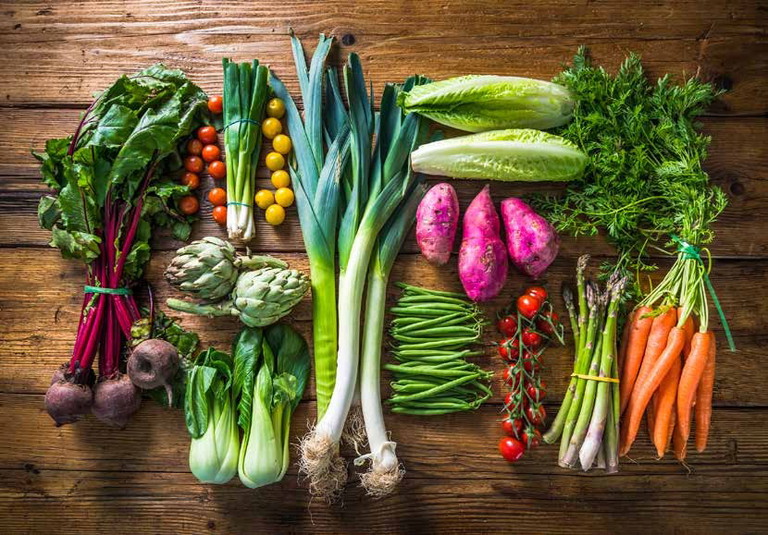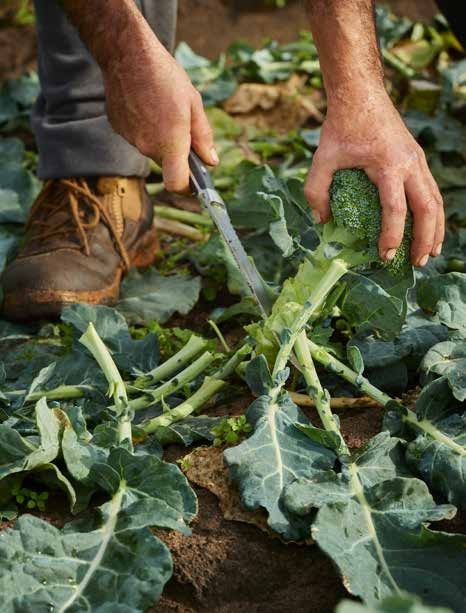trends
WHAT consumers want
Hort Innovation has released the first of its Produce Pulse findings into consumer behaviour – here’s what you need to know.

THE ability to base decisions on hard facts rather than opinions is paramount for the vegetables industry. Wendy Hubbard, Hort Innovation consumer insights manager, and Cori Hodge, director at Fiftyfive5 Research, recently presented the findings of their innovative Produce Pulse Program. This program, which surveys 800 consumers monthly, is an ‘alwayson’ survey, with more than 10,000 consumers surveyed since its inception. The survey includes a core metric module and a couple of thought-leadership or flexible modules on a range of different issues. The goals? To keep a finger on the pulse of economic issues influencing demand, understand the biggest challenges in driving growth, explore the role of provenance and examine the influence of confidence and sustainability on consumption.
Pricing and value
One of the most intriguing findings from the Produce Pulse Program is the consumer perception of vegetable prices. Sixty-two per cent of people thought that prices had significantly increased, with 94 per cent believing there had been at least a slight increase. Yet, despite these perceived price hikes, the majority of consumers still believe they're getting their money's worth when purchasing vegetables. This perception of value, even in the face of rising prices, is a testament to the resilience of consumer confidence in the vegetable market.
However, consumer behaviour is undergoing a significant transformation. This shift is marked by a surge in the purchase of discounted items, a heightened scrutiny of quality and a trend towards substituting expensive items for cheaper alternatives. A recent study revealed 43 per cent of consumers are buying more vegetables when they're on special or discounted, a 7 per cent increase from the previous year. Additionally, 36 per cent are examining the quality of their vegetables more closely and 33 per cent are substituting vegetables for cheaper alternatives.
In the face of economic pressures, consumers are trading up into 'everyday indulgences'. This term refers to affordable luxuries that consumers opt for when more expensive indulgences, such as dining out or holidays, become out of reach. In the context of fruits and vegetables, categories like berries or summer fruits are considered everyday indulgences.
As consumers save money elsewhere, they may trade up into these categories or trade down into affordable household staples, such as cheaper vegetables.
Marketing strategies play a crucial role in influencing these consumer choices. One of the key metrics captured in the study was 'top-ofmind planning', where consumers were asked what they planned to buy in the next seven days. Without any prompting, 45 per cent of consumers said they planned to buy carrots, 41 per cent potatoes and 38 per cent broccoli. However, when given a list of categories, the number of consumers planning to buy mushrooms jumped from 10 per cent to 43 per cent. This highlights the importance of communication and marketing tools, such as billboards or store displays, in nudging consumers towards certain purchases.
Satisfaction
The study also examined consumer satisfaction levels with different vegetable categories. Satisfaction was highest for mushrooms and sweet potatoes, with 59 per cent of consumers expressing high satisfaction. In contrast, leafy vegetables scored the lowest satisfaction rate at 43 per cent, with the average satisfaction rate across all categories being 51 per cent.
Within the vegetable industry is an opportunity for significant growth. This potential is intricately tied to consumer satisfaction trends and the willingness of consumers to experiment with a wider variety of vegetables. The key to unlocking this growth lies in empowering consumers to feel confident and creative in their use of vegetables, thereby driving industry expansion.
“ ... there is a pressing need to emphasise [vegetables’] ease of use and inspire creativity in their preparation to boost consumer confidence ”


Growth has been somewhat stymied by a lack of consumer confidence in trying new vegetables and using them in different culinary contexts. A case in point is the avocado, which was once a relatively unknown fruit. Today, it has become a breakfast staple, demonstrating the potential for growth when consumers are encouraged to experiment with different uses.
Creativity and buying
Respondents were asked to agree or disagree with three statements: "I tend to eat the same fruit and vegetables", "I enjoy being creative with food" and "I don't know how to prepare or cook a lot of the fresh produce I see". The responses to these statements revealed a correlation between creativity, knowledge of preparation and the variety of fruits and vegetables purchased.
As people age, they tend to enjoy being creative with food less, but they also tend to be more knowledgeable about food preparation. This is because they have established habits, rituals and recipes. However, this can be a barrier to the introduction of new vegetables into their diets.
“ ...the taste factor has a more significant impact on love for a food category than its health benefits ”
The survey also revealed a significant difference in the variety of fruits and vegetables purchased by those who feel confident in their cooking skills and those who do not. On average, those who felt confident in their cooking skills purchased seven different types of fruits and vegetables in a week, one more than those who lacked confidence. This suggests that increasing consumer confidence in cooking and preparation skills could lead to an increase in the variety of vegetables purchased.
Recent research has also unveiled that potatoes and mushrooms are perceived as the easiest to cook and eat (over half the participants registered this response), while leafy vegetables and onions are often viewed as less convenient. This association has been built over time, particularly in the mushroom category, thanks to effective communication campaigns. For instance, the 'Chop Up' campaign highlighted the simplicity of incorporating mushrooms into meals, thereby reinforcing their ease of use.
However, the study also identified a second tier of vegetables, including sweet potatoes and hard vegetables, which were perceived as moderately easy to cook and eat. The third tier, comprising leafy vegetables and onions, was deemed less easy. For those vegetables falling into the second and third tiers, there is a pressing need to emphasise their ease of use and inspire creativity in their preparation to boost consumer confidence.
For vegetables in the first tier, the focus should be on inspiring consumers with new ways of using these produce. The goal is to encourage their use in different meals and occasions – ie vegetables for breakfast. For the second tier, the aim should be to stimulate experimentation with new produce. For the third tier, the focus should be on education. Consumers need to be informed about the versatility and ease of use of these vegetables. For instance, onions can be used for a wide variety of purposes.
Emotional connection
Beyond the practical aspects of cooking and eating, the emotional connection that consumers have with food categories is crucial. This connection serves as a buffer against price sensitivity. Therefore, fostering a love for vegetables is essential.
However, the question arises: how is this emotional connection forged? The answer is: taste. While health benefits are an important aspect of food consumption, they take a backseat when it comes to vegetables. Consumers assume vegetables are healthy, and while specific health benefits can sometimes motivate purchases, it's the deliciousness that drives it.
When asked whether they associated certain food categories with being delicious or healthy, respondents who associated a category with deliciousness were 2.2 times more likely to purchase. In contrast, associating a category with healthiness had little impact on their emotional connection.
This finding underscores the importance of taste in the food industry's marketing strategies.
Provenance
Despite a strong preference for local produce, many Australians had trouble identifying if produce was locally sourced or imported. This disconnect between consumer preference and knowledge presents a challenge for the industry and raises questions about marketing and labelling practices.
It was found that 71 per cent of Australians believe that Australian produce is of superior quality.
“ Australians have a deepseated trust in the quality of local produce over imported ones ”
Furthermore, only 26 per cent of people trust the quality of imported produce. However, 70 per cent of people were unsure about the origin of the fruit and vegetables they purchased.
This lack of clarity is not due to consumer apathy. Eighty three per cent of people try to buy Australian fresh produce whenever they can. The issue lies in the difficulty of determining the origin of the produce. This is an industry challenge.
Are current labelling practices clear and transparent? Are consumers being provided with enough information to make informed choices? Research suggests perhaps not.
Sustainability
Despite a significant concern for environmental issues, there is a noticeable discrepancy between what Australians say and what they actually do.
This ‘say-do gap’ is 11 per cent between those who express concern for the environment and those who allow this concern to influence their daily behaviour. Forty one per cent of Australians are extremely concerned about environmental issues, including climate change. However, only 30 per cent stated this strongly influences their day-to-day decisions. This ‘say-do gap’ is particularly prevalent among lower income earners.
Interestingly, when asked who should be responsible for driving change and leading the way towards sustainability, many Australians pointed towards the government (72 per cent).
This perception, while reducing the immediate pressure on industry, presents a golden opportunity for vegetable businesses to exceed public expectations by taking proactive steps towards sustainability. By “surprising and delighting” the population who believe the government should do more but do not expect the same from farmers, the vegetables industry can foster positive benefits, such as brand loyalty and increased purchase frequency.

The study also revealed 76 per cent of respondents believed environmentally friendly products cost more and 68 per cent expressed concern about the impact of climate change on food supply. Only 39 per cent agreed farmers need to do more to reduce their impact on climate change. These results highlight many opportunities.